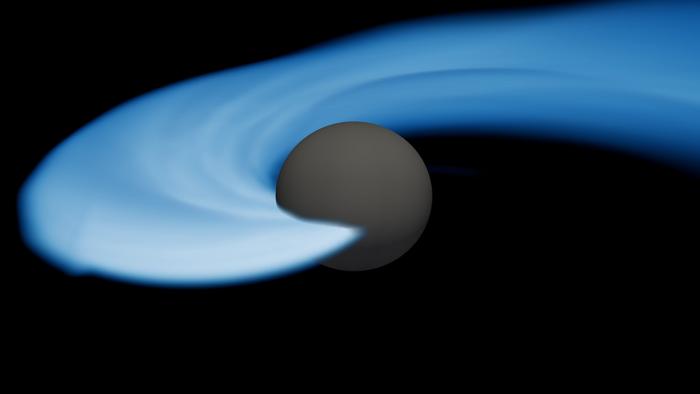Researchers from the University of Portsmouth’s Institute of Cosmology and Gravitation (ICG) have helped to detect a remarkable gravitational-wave signal, which could hold the key to solving a cosmic mystery.

Credit: I. Markin (Potsdam University), T. Dietrich (Potsdam University and Max Planck Institute for Gravitational Physics), H. Pfeiffer, A. Buonanno (Max Planck Institute for Gravitational Physics).
Researchers from the University of Portsmouth’s Institute of Cosmology and Gravitation (ICG) have helped to detect a remarkable gravitational-wave signal, which could hold the key to solving a cosmic mystery.
The discovery is from the latest set of results announced today (5 April) by the LIGO–Virgo–KAGRA collaboration, which comprises more than 1,600 scientists from around the world, including members of the ICG, that seeks to detect gravitational waves and use them for exploration of fundamentals of science.
In May 2023, shortly after the start of the fourth LIGO-Virgo-KAGRA observing run, the LIGO Livingston detector in Louisiana, USA, observed a gravitational-wave signal from the collision of what is most likely a neutron star with a compact object that is 2.5 to 4.5 times the mass of our Sun.
Neutron stars and black holes are both compact objects, the dense remnants of massive stellar explosions. What makes this signal, called GW230529, intriguing is the mass of the heavier object. It falls within a possible mass-gap between the heaviest known neutron stars and the lightest black holes. The gravitational-wave signal alone cannot reveal the nature of this object. Future detections of similar events, especially those accompanied by bursts of electromagnetic radiation, could help to solve this.
“This detection, the first of our exciting results from the fourth LIGO-Virgo-KAGRA observing run, reveals that there may be a higher rate of similar collisions between neutron stars and low mass black holes than we previously thought,” says Dr Jess McIver, Assistant Professor at the University of British Columbia and Deputy Spokesperson of the LIGO Scientific Collaboration.
As this event was seen by only one gravitational-wave detector, assessing whether it is real or not becomes more difficult.
Dr Gareth Cabourn Davies, a Research Software Engineer in the ICG, developed the tools used to search for events in a single detector. He said: “Corroborating events by seeing them in multiple detectors is one of our most powerful tools in separating signals from noise. By using appropriate models of the background noise, we can judge an event even when we don’t have another detector to back up what we have seen.”
Before the detection of gravitational waves in 2015, the masses of stellar-mass black holes were primarily found using x-ray observations while the masses of neutron stars were found using radio observations. The resulting measurements fell into two distinct ranges with a gap between them from about 2 to 5 times the mass of our Sun. Over the years, a small number of measurements have encroached on the mass-gap, which remains highly debated among astrophysicists.
Analysis of the signal GW230529 shows that it came from the merger of two compact objects, one with a mass between 1.2 to 2.0 times that of our Sun and the other slightly more than twice as massive.
While the gravitational-wave signal does not provide enough information to determine with certainty whether these compact objects are neutron stars or black holes, it seems likely that the lighter object is a neutron star and the heavier object a black hole. Scientists in the LIGO-Virgo-KAGRA Collaboration are confident that the heavier object is within the mass gap.
Gravitational-wave observations have now provided almost 200 measurements of compact-object masses. Of these, only one other merger may have involved a mass-gap compact object – the signal GW190814 came from the merger of a black hole with a compact object exceeding the mass of the heaviest known neutron stars and possibly within the mass gap.
“While previous evidence for mass-gap objects has been reported both in gravitational and electromagnetic waves, this system is especially exciting because it’s the first gravitational-wave detection of a mass-gap object paired with a neutron star,” says Dr Sylvia Biscoveanu from Northwestern University. “The observation of this system has important implications for both theories of binary evolution and electromagnetic counterparts to compact-object mergers.”
The fourth observing run is planned to last for 20 months including a couple of months break to carry out maintenance of the detectors and make a number of necessary improvements. By January 16, 2024, when the current break started, a total of 81 significant signal candidates had been identified. GW230529 is the first of these to be published after detailed investigation.
The fourth observing run will resume on 10 April 2024 with the LIGO Hanford, LIGO Livingston, and Virgo detectors operating together. The run will continue until February 2025 with no further planned breaks in observing.
While the observing run continues, LIGO-Virgo-KAGRA researchers are analysing the data from the first half of the run and checking the remaining 80 significant signal candidates that have already been identified. By the end of the fourth observing run in February 2025, the total number of observed gravitational-wave signals should exceed 200.



